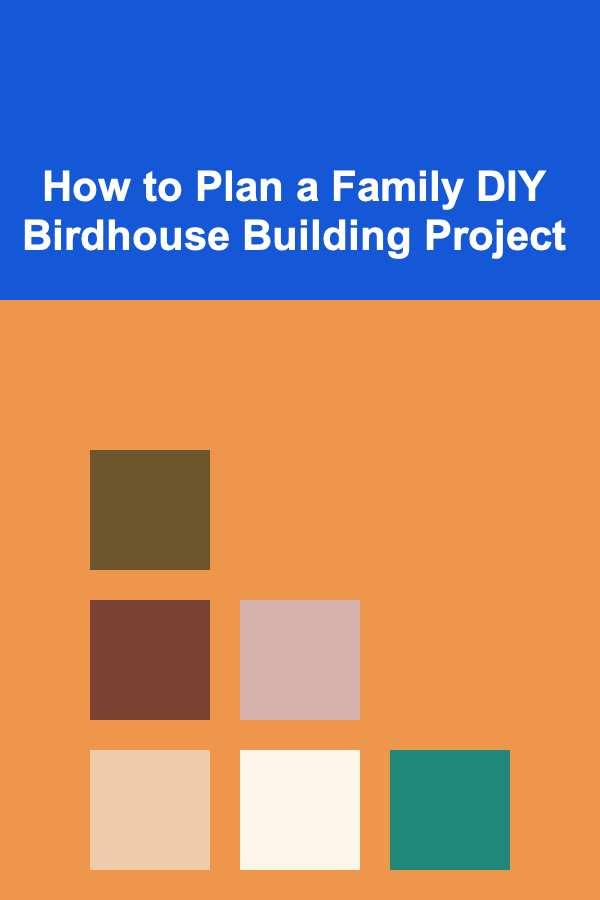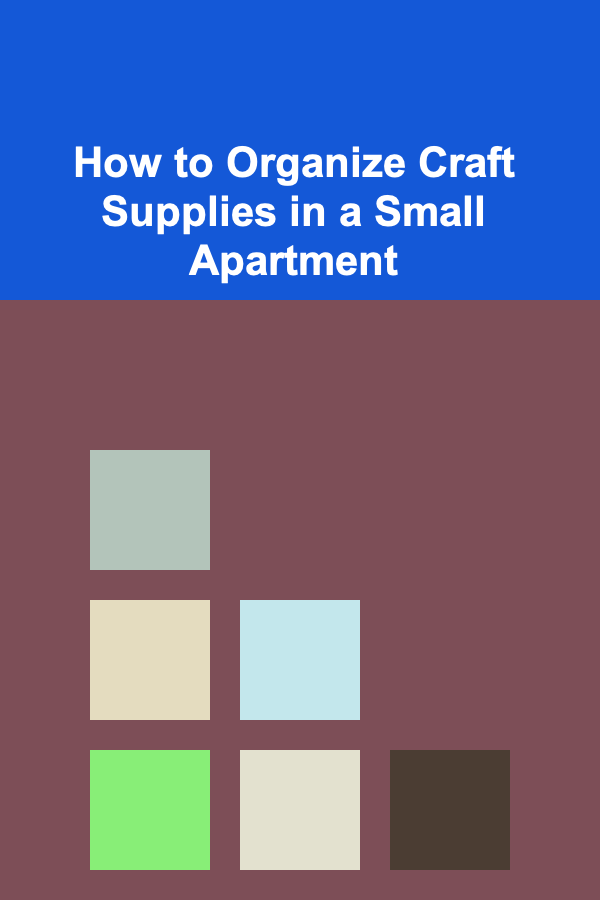
How to Plan a Family DIY Birdhouse Building Project
ebook include PDF & Audio bundle (Micro Guide)
$12.99$9.99
Limited Time Offer! Order within the next:

A DIY birdhouse building project can be a wonderful way for families to spend time together while fostering creativity, learning new skills, and making memories. Not only do you get to build something beautiful, but you also contribute to nature by providing a home for local birds. Whether you're looking for a fun weekend activity, a bonding experience, or an educational project, building a birdhouse together is an excellent choice.
This guide will walk you through every step of planning and executing a family DIY birdhouse project, including design considerations, materials, tools, assembly instructions, and tips for making the experience enjoyable for everyone involved.
Why Build a Birdhouse?
Before diving into the technical aspects, it's important to understand the benefits of building a birdhouse as a family project:
- Educational Value: A birdhouse project is an excellent opportunity to teach children about birds and nature. As you build, you can discuss the importance of bird habitats, different bird species, and how birdhouses serve as safe shelters for nesting birds.
- Enhancing Creativity: Designing and decorating the birdhouse allows everyone to use their imagination. It's a perfect activity to spark creativity and encourage problem-solving.
- Bonding Time: Building a birdhouse is a hands-on experience that can help families bond. Working together to solve problems and create something functional is a great way to strengthen relationships.
- Environmental Contribution: Providing homes for birds contributes to local wildlife conservation. With many bird species facing challenges due to habitat loss, a birdhouse can offer a safe place for them to nest and thrive.
- Aesthetic Appeal: Not only will your birdhouse provide shelter for birds, but it can also be a beautiful piece of art in your garden or yard. By customizing the design and colors, you can create something that enhances your outdoor space.
Step 1: Plan Your Project
The first step in your DIY birdhouse project is to plan it out. This involves choosing the right design, gathering materials, and making a timeline for completion.
1.1 Choose a Birdhouse Design
The design of your birdhouse should be based on a few key factors, such as the type of birds you want to attract, the available space in your yard, and the skill level of the people involved in the project. There are several design options, from simple to more intricate ones:
- Simple Wooden Box: The most basic birdhouse design is a simple rectangular box with an entrance hole. It's easy to build and requires minimal materials.
- Modern Birdhouse: For families who enjoy a challenge, modern birdhouses feature sleek, contemporary designs. These can include geometric shapes, angular lines, and unique aesthetics. However, these designs may be more complex and require additional tools and skills.
- Natural Log Birdhouse: For a more rustic look, you can create a birdhouse that mimics the appearance of a tree trunk or log. This type of birdhouse is ideal for woodpeckers and other cavity-nesting species.
- Decorative Birdhouse: Families with a flair for creativity may prefer a decorative birdhouse that doubles as outdoor art. You can shape it into a small cottage, barn, or even a whimsical design like a fairy house.
1.2 Research the Birds You Want to Attract
To ensure that your birdhouse serves its intended purpose, research the bird species you want to attract. Different species require different sizes of entrance holes and house dimensions. For example:
- Bluebirds: Prefer a birdhouse with an entrance hole of 1.5 inches in diameter and a house depth of 8--10 inches.
- Wrens: Enjoy birdhouses with a smaller entrance hole of 1 inch and a depth of 5--6 inches.
- Chickadees: A small entrance hole of 1.25 inches and a depth of 8 inches is ideal.
By choosing the right size and design, you ensure that the birdhouse is comfortable and safe for the birds that visit.
1.3 Gather Materials and Tools
Once you've decided on the design, the next step is to gather the materials and tools you'll need to build the birdhouse. Some common materials include:
- Wood: The best wood for birdhouses is untreated pine, cedar, or plywood. These woods are durable and weather-resistant but safe for birds.
- Nails or Screws: To hold the birdhouse together, you'll need nails or screws. A drill with appropriate drill bits for pilot holes will be helpful.
- Paint and Brushes: If you plan to decorate your birdhouse, non-toxic, water-based paint is ideal. Avoid using harsh chemicals that could harm birds.
- Sandpaper: To smooth out rough edges and prevent birds from getting injured, sanding is crucial.
- Roofing Material: Some birdhouses feature a waterproof roof made from shingles or metal to protect the interior from rain and weather.
Make sure to gather these materials in advance and have a well-organized workspace to start your project.
Step 2: Build the Birdhouse
Now that you've gathered all the necessary materials and have a solid plan in place, it's time to start building the birdhouse. Below is a simple step-by-step guide for creating a basic birdhouse. Adapt these instructions based on the complexity of the design you've chosen.
2.1 Cut the Wood Pieces
Begin by cutting the wood into the necessary pieces. If you're working with young children, consider pre-cutting the pieces to save time and effort. Here's a general list of pieces you'll need for a basic rectangular birdhouse:
- Back: A rectangular piece, approximately 10--12 inches tall and 6--8 inches wide.
- Front: A piece of the same width as the back, but with a hole for the bird's entrance. The hole should be centered and sized according to the bird species you're attracting.
- Sides: Two pieces that are 6--8 inches tall and 5--7 inches wide.
- Bottom: A square or rectangular piece, typically 5--6 inches wide.
- Roof: Two pieces, one for the slanted roof and one for the overhang. These should be slightly larger than the house for proper coverage.
Use a saw to carefully cut the wood pieces to the correct dimensions. If you're using plywood, you may need to use a jigsaw to cut the entrance hole.
2.2 Assemble the Birdhouse
Once all the pieces are cut, it's time to assemble the birdhouse. Use nails or screws to attach the sides to the back piece. When attaching the front, make sure that the entrance hole is at the proper height and center for birds to access easily.
The roof should be attached last to allow for proper overhang. If you've decided to include a waterproof covering, this can be done now as well.
2.3 Sand the Edges
After the structure is assembled, use sandpaper to smooth out any rough edges. Birds have sensitive skin, so it's essential that the interior and exterior of the birdhouse are free from sharp edges.
2.4 Add Ventilation and Drainage Holes
Birdhouses should have adequate ventilation and drainage to keep the interior dry and well-ventilated. Drill a few small holes near the top of the birdhouse for ventilation. Additionally, drill small holes in the bottom to allow rainwater to drain out, preventing mold and mildew buildup.
2.5 Attach a Mounting Post or Hanger
Decide whether you want to hang your birdhouse from a tree, mount it on a post, or place it on a ledge. You'll need to attach a mounting post or hanger at the top or back of the birdhouse. Ensure it is secure and stable to prevent the birdhouse from falling.
Step 3: Decorate and Personalize
Once the birdhouse is assembled, it's time to get creative. Decorate it to suit your style, or let the children unleash their imagination with their own artistic ideas.
3.1 Paint and Decorate
Paint the birdhouse with non-toxic paint. Consider using bright colors to make it stand out in your garden. You can also paint designs such as flowers, trees, or even small animals to make the birdhouse feel more whimsical.
For a more natural look, leave the wood unfinished, or use natural wood stains that are safe for outdoor use. Keep in mind that the paint should be non-toxic and eco-friendly, ensuring that it won't harm the birds.
3.2 Add Decorative Elements
Add fun, nature-inspired elements to the birdhouse, such as:
- Moss: Attach some moss to the outside of the birdhouse for a rustic, nature-inspired touch.
- Twigs and Branches: Use twigs or small branches to create additional decoration on the roof or around the entrance.
- Rope or String: Wrap colorful rope or twine around the birdhouse for added texture and color.
3.3 Name Your Birdhouse
Create a name for your birdhouse as a family activity. This can be a fun way to personalize the project and make it feel even more special. Write the name on the back or a side of the birdhouse, or use stencils to paint it on.
Step 4: Install the Birdhouse
After completing the birdhouse, the final step is installing it in your yard. Choose a location that provides safety and privacy for the birds, ideally somewhere high up, away from predators. If possible, place it near trees or shrubs to offer birds additional cover.
Ensure that the entrance hole is facing away from prevailing winds to prevent rain from entering the house. If you're mounting it on a pole, make sure it's sturdy enough to withstand wind and weather.
Step 5: Monitor and Maintain
After the birdhouse is installed, keep an eye out for visitors. If you've designed it correctly, you may soon see birds arriving to inspect their new home. Make sure to monitor the birdhouse throughout the year, particularly during the nesting season, to ensure that it remains safe and clean.
5.1 Clean the Birdhouse Annually
Once the nesting season is over, clean out the birdhouse to remove old nesting materials. This will help prevent pests and provide a fresh start for the next group of birds. Use a mild detergent and water to clean the interior, but avoid using harsh chemicals.
5.2 Repaint and Repair
Over time, exposure to the elements can cause the paint to fade or the structure to become damaged. Repaint the birdhouse as needed, and make repairs if any part of it is deteriorating.
Conclusion
Building a DIY birdhouse is a fantastic way for families to come together and engage in a hands-on, creative project. From planning and gathering materials to constructing and decorating, every step offers an opportunity for learning and fun. Plus, by providing a safe, comfortable home for birds, your family is contributing to the environment and promoting wildlife conservation.
Whether you're a beginner or an experienced builder, this project is accessible for all ages and skill levels. The most important part is to enjoy the process, celebrate your accomplishments, and appreciate the beauty of nature around you. Happy birdhouse building!
Reading More From Our Other Websites
- [Personal Care Tips 101] How to Choose an Eye Cream That Helps with Stress-Induced Dark Circles
- [Simple Life Tip 101] How to Practice Mindful Breathing Techniques While Working From Home
- [Screen Printing Tip 101] Common Stencil Mistakes and How to Fix Them for Flawless Prints
- [Home Staging 101] How to Stage a Home on a Budget
- [Home Security 101] How to Protect Your Home from Social Engineering and Scams
- [Home Cleaning 101] How to Properly Clean and Care for Your Hardwood Floors
- [Personal Investment 101] How to Use Dollar-Cost Averaging to Reduce Risk
- [Scrapbooking Tip 101] Mastering the Art of Layering: Depth and Dimension in Scrapbooking
- [Home Security 101] How to Secure Your Home Without Breaking the Bank
- [Gardening 101] Essential Tips for Growing a Thriving No-Dig Garden

How to Build a Checklist for Practicing Self-Care Daily: An Actionable Guide
Read More
How to Keep Your Car Organized When You Have Limited Space
Read More
How to Organize Craft Supplies in a Small Apartment
Read More
How to Reduce Noise in a Home Theater with Simple Soundproofing Tips
Read More
How to Understand Blockchain for Robotic Process Automation
Read More
How to Plan a Holiday Budget That Works
Read MoreOther Products

How to Build a Checklist for Practicing Self-Care Daily: An Actionable Guide
Read More
How to Keep Your Car Organized When You Have Limited Space
Read More
How to Organize Craft Supplies in a Small Apartment
Read More
How to Reduce Noise in a Home Theater with Simple Soundproofing Tips
Read More
How to Understand Blockchain for Robotic Process Automation
Read More